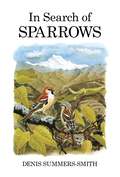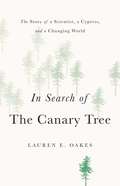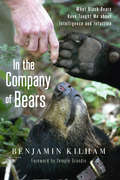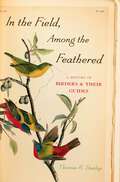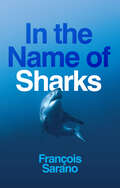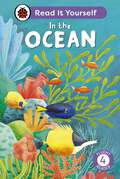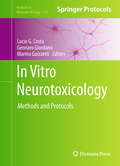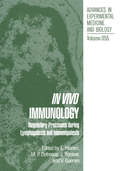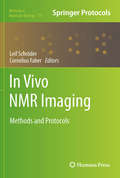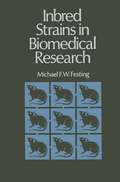- Table View
- List View
In Search of Sparrows (Poyser Monographs #95)
by Denis Summers-SmithDenis Summers-Smith first took up the study of the House Sparrow in 1947, thinking that the difficulties of travel in post-war Britain would best suit the study of a species always close at hand. The humble House Sparrow, common everywhere, was surprisingly poorly researched and his work soon provided interesting insights into this successful and adaptable little bird. As new opportunities to travel opened up, his interest blossomed to take in the genus Passer as a whole. His travels would ultimately lead to his study of all but one group, found only in the deepest Turkestan, and to the publication of his authoritative monograph on sparrows in 1988.While that book presented his knowledge of sparrow biology, this volume tells the other, human, side of the tale. His wry descriptions of the tribulations and unexpected pleasures of a traveller on four continents, from the Himalayas and Thailand, to Africa and the Americas (with a good few islands in between) are interspersed with observations and speculations on the biology of sparrows in a wide variety of habitats. Everywhere local officials and birdwatchers warmed to the eccentric Scot in pursuit of the little birds that nobody notices but which so often make their homes beside us.The author's own photographs and delightful cartoons by Euan Dunn further paint the picture of this lifelong search.
In Search of the African Lion
by Roger de la Harpe Pat de la HarpeThe African lion (Panthera leo), long celebrated as the king of beasts, faces unprecedented challenges in the wild today. Loss of habitat through the expansion of human activity increasingly restricts the lion to game reserves and national parks, while diseases such as bovine tuberculosis pose a threat to the health of lion prides. Over a period of two years, Roger and Pat de la Harpe have documented wild lions of South Africa, and the result is a superbly photographed and engagingly written tribute to this often misunderstood predator. In Search of the African Lion enters the complex world of the lion, describing pride dynamics, hunting patterns, the reproductive cycle and interactions with human communities. The book focuses on four main areas: the Kalahari, the Madikwe/Mapungubwe area, the Greater Kruger National Park and Northern Zululand -each with its own problems, challenges and opportunities. In addition, the authors highlight the important work done by game rangers, wildlife managers and scientific researchers in understanding the lion and in protecting existing populations. The In Search of… series focuses on the plight of threatened and endangered species. Also available by the same authors: In Search of the African Wild Dog.
In Search of the Canary Tree: The Story of a Scientist, a Cypress, and a Changing World
by Lauren E. OakesThe award-winning and surprisingly hopeful story of one woman's search for resiliency in a warming worldSeveral years ago, ecologist Lauren E. Oakes set out from California for Alaska's old-growth forests to hunt for a dying tree: the yellow-cedar. With climate change as the culprit, the death of this species meant loss for many Alaskans. Oakes and her research team wanted to chronicle how plants and people could cope with their rapidly changing world. Amidst the standing dead, she discovered the resiliency of forgotten forests, flourishing again in the wake of destruction, and a diverse community of people who persevered to create new relationships with the emerging environment. Eloquent, insightful, and deeply heartening, In Search of the Canary Tree is a case for hope in a warming world.
In Silico Bees
by James DevillersBees are critically important for ecosystem function and biodiversity maintenance through their pollinating activity. Unfortunately, bee populations are faced with many threats, and evidence of a massive global pollination crisis is steadily growing. As a result, there is a need to understand and, ideally, predict how bees respond to pollution dist
In Silico Bees
by James DevillersBees are critically important for ecosystem function and biodiversity maintenance through their pollinating activity. This book provides a collection of computational methods to those primarily interested in the study of the ecology, ethology, and ecotoxicology of bees. It presents numerous case studies to enable readers to understand the appropriateness but also the limitations of models in theoretical and applied bee research. Written by an international team of experts, this book covers the main types of modeling approaches that can be used in terrestrial ecology and applied ecotoxicology.
In Situ Hybridization Methods (Neuromethods #99)
by Giselbert HauptmannThis volume contains a comprehensive compilation of chromogenic and fluorescent RNA in situ hybridization (ISH) technology in many of its various shades, forms, and applications. The book is organized into a number of parts and chapters focusing on the application of ISH methodologies to different animal species as used in Evolutionary Development (EvoDevo) and Biomedical research, and covering new developments in RNA visualization by fluorescent ISH (FISH). The described (F)ISH protocols employ effective strategies for signal enhancement and target amplification allowing for high signal intensities and drastically improved signal-to-noise ratios. Chromogenic and fluorescent ISH, as specified in the various chapters, are most essential for RNA expression profiling, applied to many fields of research including cellular, developmental, and evolutionary biology, neurobiology and neuropathology. Written for the popular Neuromethods series, chapters include the kind of detail and key implementation advice that ensures successful results in the laboratory.Essential and authoritative, In Situ Hybridization Methods provides detailed protocols for newcomers to ISH, and inspires researchers familiar with the technique to seek and find up-to-date methodology for new and specialized applications.
In the Air (Discover the Dinosaurs #4)
by Jeremy SmithBite-sized information and handy comparison stats help you get to grips with pterosaurs. Lavish illustrations bring the exciting world of these prehistoric fliers back to life.
In the Company of Bears: What Black Bears Have Taught Me about Intelligence and Intuition
by Benjamin Kilham Temple GrandinIn In the Company of Bears, originally published in hardcover as Out on a Limb, Ben Kilham invites us into the world he has come to know best: the world of black bears. For decades, Kilham has studied wild black bears in a vast tract of Northern New Hampshire woodlands. At times, he has also taken in orphaned infants–feeding them, walking them through the forest for months to help them decipher their natural world, and eventually reintroducing them back into the wild. Once free, the orphaned bears still regard him as their mother. And one of these bears, now a 17-year-old female, has given him extraordinary access to her daily life, opening a rare window into how she and the wild bears she lives among carry out their daily lives, raise their young, and communicate. Witnessing this world has led to some remarkable discoveries. For years, scientists have considered black bears to be mostly solitary. Kilham's observations, though, reveal the extraordinary interactions wild bears have with each other. They form friendships and alliances; abide by a code of conduct that keeps their world orderly; and when their own food supplies are ample, they even help out other bears in need. Could these cooperative behaviors, he asks, mimic behavior that existed in the animal that became human? In watching bears, do we see our earliest forms of communications unfold? Kilham's dyslexia once barred him from getting an advanced academic degree, securing funding for his research, and publishing his observations in the scientific literature. After being shunned by the traditional scientific community, though, Kilham’s unique findings now interest bear researchers worldwide. His techniques even aid scientists working with pandas in China and bears in Russia. Moreover, the observation skills that fueled Kilham’s exceptional work turned out to be born of his dyslexia. His ability to think in pictures and decipher systems makes him a unique interpreter of the bear's world. In the Company of Bears delivers Kilham’s fascinating glimpse at the inner world of bears, and also makes a passionate case for science, and education in general, to open its doors to different ways of learning and researching–doors that could lead to far broader realms of discovery.
In the Company of Seahorses (Wild Nature Press #32)
by Steve Trewhella Julie HatcherSeahorses are instantly recognisable and have been a part of our culture for millennia, yet we still know very little about these enigmatic creatures.Steve Trewhella and Julie Hatcher have spent hundreds of hours in British waters observing native seahorses, witnessing at first hand how they behave in the wild, and how they interact with the other plants and animals in their underwater realm.With stunning photography, In the Company of Seahorses paints a rich picture of a mysterious world amongst swaying seagrass and colourful seaweeds. The accompanying text is packed with personal anecdotes describing the authors’ journey of discovery, illustrating for the first time the secretive lives of these elusive animals in British waters.By sharing one couple’s passion for an entrancing ocean icon, this book aims to inspire, inform and create a better understanding of the seahorse and its often vulnerable habitats around the British coastline.
In the Field, Among the Feathered: A History of Birders and Their Guides
by Thomas R. DunlapAmerica is a nation of ardent, knowledgeable birdwatchers. But how did it become so? And what role did the field guide play in our passion for spotting, watching, and describing birds? In the Field, Among the Feathered tells the history of field guides to birds in America from the Victorian era to the present, relating changes in the guides to shifts in science, the craft of field identification, and new technologies for the mass reproduction of images. Drawing on his experience as a passionate birder and on a wealth of archival research, Thomas Dunlap shows how the twin pursuits of recreation and conservation have inspired birders and how field guides have served as the preferred method of informal education about nature for well over a century. The book begins with the first generation of late 19th-century birdwatchers who built the hobby when opera glasses were often the best available optics and bird identification was sketchy at best. As America became increasingly urban, birding became more attractive, and with Roger Tory Peterson's first field guide in 1934, birding grew in both popularity and accuracy. By the 1960s recreational birders were attaining new levels of expertise, even as the environmental movement made birding's other pole, conservation, a matter of human health and planetary survival. Dunlap concludes by showing how recreation and conservation have reached a new balance in the last 40 years, as scientists have increasingly turned to amateurs, whose expertise had been honed by the new guides, to gather the data they need to support habitat preservation. Putting nature lovers and citizen-activists at the heart of his work, Thomas Dunlap offers an entertaining history of America's long-standing love affair with birds, and with the books that have guided and informed their enthusiasm.
In the Field, Among the Feathered: A History of Birders and Their Guides
by Thomas R. DunlapAmerica is a nation of ardent, knowledgeable birdwatchers. But how did it become so? And what role did the field guide play in our passion for spotting, watching, and describing birds? In the Field, Among the Feathered tells the history of field guides to birds in America from the Victorian era to the present, relating changes in the guides to shifts in science, the craft of field identification, and new technologies for the mass reproduction of images. Drawing on his experience as a passionate birder and on a wealth of archival research, Thomas Dunlap shows how the twin pursuits of recreation and conservation have inspired birders and how field guides have served as the preferred method of informal education about nature for well over a century. The book begins with the first generation of late 19th-century birdwatchers who built the hobby when opera glasses were often the best available optics and bird identification was sketchy at best. As America became increasingly urban, birding became more attractive, and with Roger Tory Peterson's first field guide in 1934, birding grew in both popularity and accuracy. By the 1960s recreational birders were attaining new levels of expertise, even as the environmental movement made birding's other pole, conservation, a matter of human health and planetary survival. Dunlap concludes by showing how recreation and conservation have reached a new balance in the last 40 years, as scientists have increasingly turned to amateurs, whose expertise had been honed by the new guides, to gather the data they need to support habitat preservation. Putting nature lovers and citizen-activists at the heart of his work, Thomas Dunlap offers an entertaining history of America's long-standing love affair with birds, and with the books that have guided and informed their enthusiasm.
In the Footsteps of Audubon
by Denis ClavreulAn artist’s uniquely personal journey across AmericaIn the nineteenth century, ornithologist and painter John James Audubon set out to create a complete pictorial record of North American birdlife, traveling from Louisiana and the Florida Keys to the Gulf of Saint Lawrence and the cliffs of the Yellowstone River. The resulting work, The Birds of America, stands as a monumental achievement in American art. Over a period of sixteen years, recording his own journey in journals and hundreds of original paintings, renowned French watercolorist Denis Clavreul followed in the naturalist’s footsteps.In the Footsteps of Audubon brings together some 250 of Clavreul’s stunning watercolors along with illuminating selections from Audubon’s journals and several of his paintings. With pencil and brush in hand, Clavreul turns his naturalist’s eye and painterly skill to the landscapes that Audubon encountered on his travels, and to the animals and plants that Audubon depicted in his art. A passionate ornithologist, Clavreul sketches birds in the wild with rare dexterity, bringing them vividly to life on the page. He documents his encounters along the way with people who live with nature, many of whom are passionately engaged in preserving it, drawing on his insights as both a biologist and an artist to connect the past, present, and future.A spellbinding, richly evocative journey, In the Footsteps of Audubon is an invitation to see the natural world as Audubon saw it—and to see with new eyes what it has become today.
In the Footsteps of Audubon
by Denis ClavreulAn artist’s uniquely personal journey across AmericaIn the nineteenth century, ornithologist and painter John James Audubon set out to create a complete pictorial record of North American birdlife, traveling from Louisiana and the Florida Keys to the Gulf of Saint Lawrence and the cliffs of the Yellowstone River. The resulting work, The Birds of America, stands as a monumental achievement in American art. Over a period of sixteen years, recording his own journey in journals and hundreds of original paintings, renowned French watercolorist Denis Clavreul followed in the naturalist’s footsteps.In the Footsteps of Audubon brings together some 250 of Clavreul’s stunning watercolors along with illuminating selections from Audubon’s journals and several of his paintings. With pencil and brush in hand, Clavreul turns his naturalist’s eye and painterly skill to the landscapes that Audubon encountered on his travels, and to the animals and plants that Audubon depicted in his art. A passionate ornithologist, Clavreul sketches birds in the wild with rare dexterity, bringing them vividly to life on the page. He documents his encounters along the way with people who live with nature, many of whom are passionately engaged in preserving it, drawing on his insights as both a biologist and an artist to connect the past, present, and future.A spellbinding, richly evocative journey, In the Footsteps of Audubon is an invitation to see the natural world as Audubon saw it—and to see with new eyes what it has become today.
In the Hearts of the Beasts: How American Behavioral Scientists Rediscovered the Emotions of Animals
by Anne C. RoseAnimals cannot use words to explain whether they feel emotions, and scientific opinion on the subject has been divided. Charles Darwin believed animals and humans share a common core of fear, anger, and affection. Today most researchers agree that animals experience comfort or pain. Around 1900 in the United States, however, where intelligence was the dominant interest in the lab and field, animal emotion began as an accidental question. Organisms ranging from insects to primates, already used to test learning, displayed appetites and aversions that pushed psychologists and biologists in new scientific directions. The Americans were committed empiricists, and the routine of devising experiments, observing, and reflecting permitted them to change their minds and encouraged them to do so. By 1980, the emotional behavior of predatory ants, fearful rats, curious raccoons, resourceful bats, and shy apes was part of American science. In this open-ended environment, the scientists' personal lives--their families, trips abroad, and public service--also affected their professional labor. The Americans kept up with the latest intellectual trends in genetics, evolution, and ethology, and they sometimes pioneered them. But there is a bottom-up story to be told about the scientific consequences of animals and humans brought together in the pursuit of knowledge. The history of the American science of animal emotions reveals the ability of animals to teach and scientists to learn.
In the Hearts of the Beasts: How American Behavioral Scientists Rediscovered the Emotions of Animals
by Anne C. RoseAnimals cannot use words to explain whether they feel emotions, and scientific opinion on the subject has been divided. Charles Darwin believed animals and humans share a common core of fear, anger, and affection. Today most researchers agree that animals experience comfort or pain. Around 1900 in the United States, however, where intelligence was the dominant interest in the lab and field, animal emotion began as an accidental question. Organisms ranging from insects to primates, already used to test learning, displayed appetites and aversions that pushed psychologists and biologists in new scientific directions. The Americans were committed empiricists, and the routine of devising experiments, observing, and reflecting permitted them to change their minds and encouraged them to do so. By 1980, the emotional behavior of predatory ants, fearful rats, curious raccoons, resourceful bats, and shy apes was part of American science. In this open-ended environment, the scientists' personal lives--their families, trips abroad, and public service--also affected their professional labor. The Americans kept up with the latest intellectual trends in genetics, evolution, and ethology, and they sometimes pioneered them. But there is a bottom-up story to be told about the scientific consequences of animals and humans brought together in the pursuit of knowledge. The history of the American science of animal emotions reveals the ability of animals to teach and scientists to learn.
In the Name of Sharks
by François SaranoTwenty metres below water, the oceanographer François Sarano came face to face with a five-and-a-half metre great white shark. Seduced by the gentle elegance of this majestic creature, Sarano experienced a profound sense of affinity with her as they swam side by side, shoulder to shoulder, eye to eye, cutting a single figure through the ocean depths. It was an experience which made him realize the depth of our ignorance of the lives of sharks, leading him to become a passionate advocate for their protection. Drawing on the latest scientific research on the biology and ethology of sharks and their exceptional characteristics, this book aims to break through the barrier of prejudice and to pay homage to their true nature. Representing a last vestige of wildness, their populations are nevertheless under threat – like so many species, they have been hunted and exploited by humans. Sarano argues for a change of mindset in which we lose ourselves in the world of the other, so that each living entity, human and non-human, can take their rightful place in the broader global ecosystem.
In the Ocean: Read It Yourself - Level 4 Fluent Reader (Read It Yourself)
by LadybirdOn Earth, you can find oceans, rock pools and coral reefs, but do you know what lives inside them? Learn all about amazing sea creatures, from sharks and whales to giant squid and glowing fish.In the Ocean is from Fluent Reader Level 4 and is ideal for more fluent readers aged from 7+ who are starting to read independently.Each book has been carefully checked by educational and subject consultants and includes comprehension puzzles, book band information, and tips for helping children with their reading.With five levels to take children from first phonics to fluent reading and a wide range of different stories and topics for every interest, Read It Yourself helps children build their confidence and begin reading for pleasure.
In the Sea (Discover the Dinosaurs #3)
by Jeremy SmithBite-sized information and handy comparison stats help you get to grips with the dinosaurs. Lavish illustrations bring the exciting world of the dinosaurs back to life.
In Vitro Effects of Mineral Dusts: Third International Workshop (Nato ASI Subseries G: #3)
by Ernst G. Beck Jean BignonThe Third International \~orkshop on "The in Vitro Effects of Mineral Dusts" was held on October 1 - 4, 1984 in Schluchsee, Black Forest, Federal Republic of Germany. In six sessions, 93 participants from 14 countries (USA 32, France 17, United Kingdom 12, FRG 11, Canada 9, Belgium 3, Hungary 1, Italy 2, India 1, Nether lands 1, Norway 1, Poland 1, Portugal 1, Turkey 1) treated and discussed the following subjects: - Significance of the physico-chemical properties of inhalable mineral dusts (mine dusts, asbestos, Man-Made Mineral Fibres - MMMF). - Cellular effects of inhalable mineral dusts with special regard to target ce 11 s. - Immune response and immune toxicity. - Carcinogenicity and interrelated genotoxic and non-genotoxic effects. - Effect of cell metabolism in combination with inflammation and fibrogenesis. - Significance and credibility of in vitro test systems. For the pathogenesis of biological effects and diseases caused by inhalable mineral dusts a number of factors may be significant such as: - Type of dust - Dose of dust - Size and shape of dust particles, and especially - Surface properties of dust particles, which inter alia determine the - sorption properties, e.g. for environmental substances.
In Vitro Neurotoxicology: Methods and Protocols (Methods in Molecular Biology #758)
by Lucio G. Costa, Gennaro Giordano and Marina GuizzettiIn recent years, the need to develop acceptable alternatives to conventional animal testing for neurotoxicity and developmental neurotoxicity has been increasingly recognized, and much effort is being directed toward the development of alternative models, utilizing mostly mammalian cells in culture but also non-mammalian model systems. In Vitro Neurotoxicology: Methods and Protocols presents a series of cellular, biochemical, and molecular methodological protocols in the area of in vitro neurotoxicology, with an emphasis on mammalian cell culture systems. Opening with a section on methodologies for preparing several cellular systems of variable complexity, amenable for in vitro neurotoxicological studies, the thorough volume continues with coverage of methods to measure cellular death and major mechanisms, methods for assessing mechanisms of nervous system cell toxicity related to impairment of cell signaling, while a final section illustrates additional methods for assessing important nervous system processes such as cell proliferation, neuritogenesis, and synaptogenesis. Written in the highly successful Methods in Molecular Biology™ series format, chapters include introductions to their respective subjects, lists of the necessary materials and reagents, step-by-step, readily reproducible laboratory protocols, and tips on troubleshooting and avoiding known pitfalls. Comprehensive and cutting-edge, In Vitro Neurotoxicology: Methods and Protocols serves researchers with an interest in assessing or characterizing the potential neurotoxicity of environmental contaminants, drugs, or other chemicals.
In Vivo Immunology: Regulatory Processes during Lymphopoiesis and Immunopoiesis (Advances in Experimental Medicine and Biology #355)
by E. Heinen M. P. Defresne J. Boniver V. GeenenThe 11th International Conference on Lymphoid Tissues and Immune Reactions was held in Spa-Liege (Belgium), from 4 to 8 July 1993. The regular devotees refer to these conferences as the "Germinal Centre Conferences or GCC". In the 1960s, the germinal centres were the subject of such considerable study and speculation that a group of dynamic people decided to devote an international conference centered on that topic. This led to the fIrst GCC organized in Bern in 1966. Following the success of this initial meeting, further sessions have been organized at regular intervals and, over the years, the scope of the GCC has been broadened. Nowadays, the GCC conferences are dedicated to in vivo immunology and deal mainly with cellular, functional and molecular aspects of the lymphoid system. The credo of these conferences is "in vivo veritas," implying that the sole investigation of components (like molecules or cell populations) only gives a partial truth. Ultimately, the components have to be explored in their global context in order to see how they interact with other parts and how they are integrated as a whole to ensure the homeostasis of the immune system. In 1966, the GCC lasted 3 days and included 57 contributions "which were discussed at length. " The present conference lasted 4 days and accommodated 2 honorary lectures, 80 free papers and 209 poster presentations. Out of those presentations, a selection was performed by the Chairpersons to compose the present volume.
In vivo NMR Imaging: Methods and Protocols (Methods in Molecular Biology #771)
by Leif Schröder and Cornelius FaberNuclear magnetic resonance imaging represents a technique that is indispensable in every day biomedical diagnostics. Thanks to the numerous ways to manipulate and detect an NMR signal, it is possible to obtain a variety of information with excellent spatial and temporal resolution. Today’s MRI techniques go far beyond the illustration of pure anatomical structures and include the revealing of processes down to the molecular level. The number of small animal imaging centers relying on MRI as a key method for preclinical research to understand diseases and to test for novel treatments is growing rapidly. In Vivo NMR Imaging: Methods and Protocols is written as an experimental laboratory text to provide a descriptive approach of the various applications of magnetic resonance imaging and its underlying principles. Starting from a compact introduction of basic NMR physics and image encoding techniques suitable for a broad audience in the life sciences, the concept focuses on addressing the many ways of generating contrast in MR images. The authors cover an interdisciplinary range of problems to be addressed by this non-invasive modality, including study protocols for addressing morphological, physiological, functional, and biochemical aspects of various tissues in living organisms. Information about practical aspects of designing experimental studies that follow the special conditions for micro imaging setups are also provided. Written in the successful Methods in Molecular Biology™ series format, In Vivo NMR Imaging: Methods and Protocols aims to be an experimental compendium of modern in vivo MR imaging with special focus on recent developments in molecular imaging and new protocols for imaging metabolism and molecular markers.
The Inadequate Environment: Nitrogen and the Abundance of Animals
by Thomas C.R. WhiteEcology is characterized by a rapidly growing complexity and diversity of facts, aspects, examples, and observations. What is badly needed is the development of common patterns, of rules that, as in other sciences such as physics, can more generally explain the increasing complexity and variability we observe. Tom White, being one of the "seniors" in ecology, makes such an attempt in his book. the pattern he shows and explains with numerous examples from the entire animal kingdom is a universal hunger for nitrogen, a misery that drives the ecology of all organisms. He advocates that the awareness of this fundamental role that the limitation of nitrogen plays in the ecology of all organisms should be as a much part of each ecologis's intellectual equipment as is the awareness of the fact of evolution by means of natural selection. His claim is that not "enery" but "nitrogen" is the most limited "currency" in the animal world for the production and growth of their young.
Increasing Small Ruminant Productivity in Semi-arid Areas: Proceedings of a Workshop held at the International Center for Agricultural Research in the Dry Areas, Aleppo, Syria, 30 November to 3 December 1987 (Current Topics in Veterinary Medicine #47)
by E. F. Thomson and F. S. ThomsonProceedings of a workshop held at the International Center for Agricultural Research in the Dry Areas, Aleppo, Syria, November 30 to December 3, 1987
